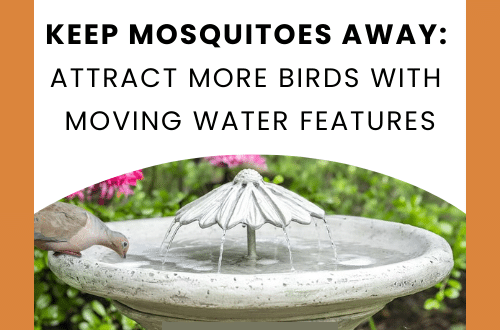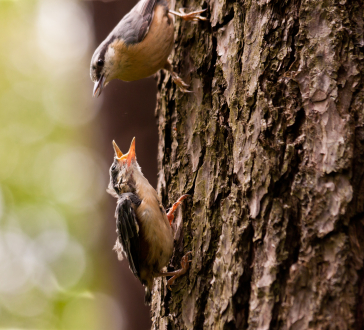-
bird seed trays can add a new dimension in feeding
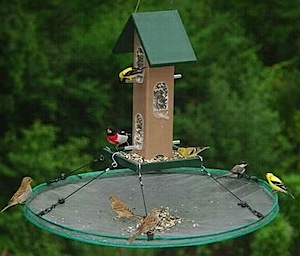 They’ve come a long way since the standard, puny metal or plastic tray. New designs like this Seed Hoop offer much more than a waste-free feeding area. For starters, they’re adjustable and attach to almost any feeder, regardless of its size. Combined with a huge 30-inch diameter, these bird seed trays catch any and all fallen seed, and so versatile, they can even be pole mounted below a feeder. Sturdy mesh makes them a snap to clean with the hose, light-weight, easy to handle, and no tools required.
They’ve come a long way since the standard, puny metal or plastic tray. New designs like this Seed Hoop offer much more than a waste-free feeding area. For starters, they’re adjustable and attach to almost any feeder, regardless of its size. Combined with a huge 30-inch diameter, these bird seed trays catch any and all fallen seed, and so versatile, they can even be pole mounted below a feeder. Sturdy mesh makes them a snap to clean with the hose, light-weight, easy to handle, and no tools required.Also available in a smaller 16-inch diameter, they create a generous platform area that’s like having a second bird feeder. New visitors who’ve never used the feeder, especially during spring migrations, are likely to stop by and grace your yard! In the last few days we’ve been watching a stunning pair of red breasted grosbeaks chowing down on sunflower mix. They eat fallen seed on the tray, as well as from the feeder itself.
Although grosbeaks have
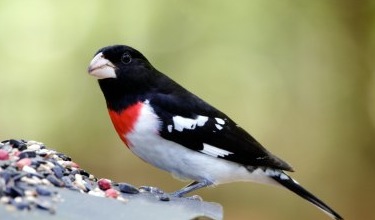 visited in past years, their appearance has always been brief. Maybe these large bird seed trays have enticed them to stick around longer this season? We sure hope so!
visited in past years, their appearance has always been brief. Maybe these large bird seed trays have enticed them to stick around longer this season? We sure hope so! -
Get big impact in a small space with a hanging bird bath
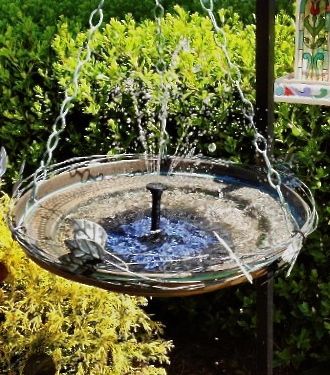 Even the smallest yard can yield colorful wild bird activity… and without ever filling a feeder. Water is the simplest way to attract birds, and moving water really grabs their attention! A simple plant saucer filled with water will see lots of activity, provided the water stays fresh. For the deck, patio or apartment balcony, various brackets and hooks will accommodate hanging baths or feeders.
Even the smallest yard can yield colorful wild bird activity… and without ever filling a feeder. Water is the simplest way to attract birds, and moving water really grabs their attention! A simple plant saucer filled with water will see lots of activity, provided the water stays fresh. For the deck, patio or apartment balcony, various brackets and hooks will accommodate hanging baths or feeders.This solar hanging bird bath is the perfect option for enticing feathered friends to just about any space. The only caveat is the fountain must be in full sun for the panel to operate. Since there are no cords or wires, energy is not stored – but real time so to speak. Not only song birds, but butterflies and hummingbirds also adore moving water, and are drawn to it like a magnet.
If you’re new the backyard birding thing… think water! Any shallow pan or bowl will do, but not too deep. An optimal depth for birds to bathe and wade comfortably is about two to three inches. If the water is any deeper, consider placing a large rock in the center for birds to land and perch. Texture helps too, as birds are able to get better footing on something that’s not too slick.
Just keep the water fresh and watch… because if you build it they will come!
-
10 Tips for Making Every Day Earth Day
From Care 2 Causes, in observance of Earth Day:
Earth Day is right around the corner (April 22), but why not commit to loving and protecting the environment every day?
1. Awaken Your Senses to nature all around you, even in the city. Just step outside, and nature is right there. Is it windy? What do the clouds look like? Is it sunny? What is the first bird that you hear?
2. Use Less Water: turning off the tap while you brush your teeth will save four gallons a minute. In the shower, turning off the water while you shampoo and condition your hair can save more than 50 gallons a week.
3. Attack The Energy Monster: always turn off the lights when you leave a room, and replace incandescent bulbs with compact fluorescent bulbs (CFLs). They are more expensive but will last much longer. Use the minimum amount of outdoor security lights by setting them on a timer or motion sensor so they turn off during the day.
4. Commute Without Polluting: take mass transit or at least carpool if you can. Best of all, ride a bike! There are huge physical and fiscal benefits to biking. The obesity rate for adults is at almost 36 percent in the U.S., while countries like the Netherlands, Sweden and Germany, which promote biking as transportation, have the lowest incidence of obesity.
5. Know The Top 10. According to the National Recycling Coalition, these are the top 10 most important items to recycle: aluminum, PET plastic bottles, newspaper, corrugated cardboard, steel cans, HDPE plastic bottles, glass containers, magazines, mixed paper and computers.
6. Just Say No to paper and plastic bags. The average consumer makes 1.9 trips to the grocery store every week. If you take home two bags each trip, that’s about 200 bags a year. Even if you recycle your bags, it’s better not to use them in the first place, due to the energy used to produce those bags. Instead, carry your stuff home from the store in a reusable tote bag.
7. Put A Cap on bottled water: roughly 50 billion plastic water bottles end up in U.S. landfills each year, which is 140 million every day. And according to the National Resources Defense Council, 40 percent of bottled water is nothing more than tap water anyway. You’ve paid taxes for your tap water, so drink it! Head out to buy some refillable water bottles.
8. Buy Locally Produced Food. When you do, you are helping reduce the pollutions and depletion of resources associated with the transportation and packaging of food. On average, domestically grown produce sold in conventional supermarkets has traveled some 1,500 miles from farm to table. Not to mention, it’s probably been treated with fungicides so that it can be stored.
9. Weigh Your Waste. I’ve done this and it’s scary to see how much my family accumulates each week. Weigh on a bathroom scale every bag of garbage you create before you take it out. Do this for a week, and multiply by 52 to get a rough estimate of how much waste you produce in a year. Then figure out how you can cut your waste production!
10. Avoid The “Print” Button. It’s an obvious one – but really, think twice before printing from the computer. You can read most documents and magazines online, and you can pay many bills via the web these days. When you do print, use both sides of your paper as much as possible.


